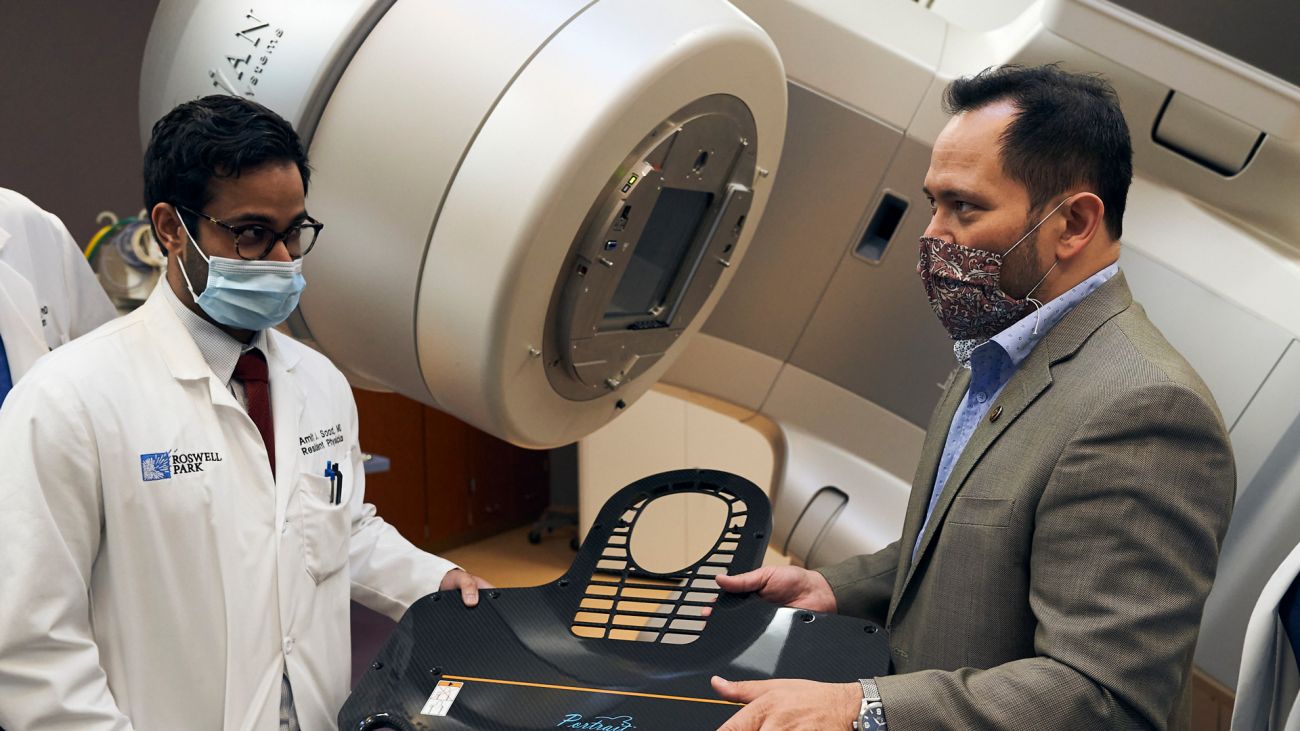External radiation therapies
External Beam Radiation Therapy (EBRT)
This technique uses a large machine called a linear accelerator (LINAC) to create and deliver radiation beams to precisely targeted areas of the body. Roswell Park’s Radiation Medicine team offers the following external radiation therapies:
3-Dimensional Conformal Radiation Therapy (3D-CRT)
Using the latest technologies available in linear accelerators with sophisticated computer software systems, 3D-CRT delivers accurate radiation to very precisely shaped target areas. 3D-CRT has become the new standard in radiation therapy, combining modern imaging such as computer tomography (CT) and magnetic resonance imaging (MRI) with the planning software.
Intensity Modulated Radiation Therapy (IMRT)
An advanced form of 3D-CRT, this treatment uses hundreds of tiny radiation beam shaping devices (collimators) to deliver a single dose of radiation. The treatment team can move the collimators to sculpt the radiation beams to the shape of the tumor, and treat the tumor from various angles. As the collimators move and shape the beam, radiation intensity can vary or modulate, allowing different areas of the tumor or nearby tissues to receive different doses of radiation.
Image-Guided Radiation Therapy (IGRT)
Uses repeating imaging scans (CT, MRI, or PET) taken during treatment to identify changes in the tumor’s size or location during treatment. Patient position and/or radiation dose can be recalculated as needed during treatment.
Gamma Knife radiosurgery
Gamma Knife radiosurgery uses special equipment to position the patient and deliver a single high dose of radiation. This treatment is used for brain tumors, lesions and other brain disorders.
Stereotactic Body Radiation Therapy (SBRT)
This radiation therapy uses special equipment to position the patient deliver a very high dose of radiation to tumors in the body (except the brain) over 1 to 3 treatment sessions. The equipment helps account for tumor movement with body movement, such as breathing. SBRT is used for some lung and liver tumors, even in patients who cannot undergo surgery.
Total Body Irradiation (TBI)
Total body irradiation (TBI) is a technique used to deliver irradiation to the entire body. TBI is part of a complex treatment program for certain conditions and can be combined with high-dose chemotherapy in preparation for blood or marrow transplantation.
Volumetric Modulated Arc Therapy (VMAT)
A more precise form of external radiation than 3D-CRT, where the radiation dose and the field shape is changed or modulated as the treatment machine moves or arcs around the patient. This treatment helps spare more normal tissue.
Internal radiation therapies
This involves placing radioactive material, such as seeds, beads, pellets, ribbons, wires or other substances inside the body. Roswell Park’s Radiation Medicine Team offers these internal radiation therapies:
Brachytherapy
Brachytherapy Uses radioactive isotopes sealed into tiny seeds or pellets and placed within the tumor tissue (called interstitial brachytherapy) used often for prostate cancer, or in a body cavity or surgical cavity near the tumor (called intracavity brachytherapy). The radioactive implant may be temporary or permanent (radiation eventually wears off) and brachytherapy treatment may be either:
- High-dose rate brachytherapy - uses one very small high radiation implant that is inserted temporarily, from minutes to hours. Treatments are given in separate sessions about six hours apart.
- Low-dose rate brachytherapy - allows continuous low-dose radiation to a treatment area over a period of several days
Intraoperative radiation therapy
Uses Roswell Park’s specially equipped surgical suite to deliver high-dose radiation during a surgical procedure. This treatment may be used to target the surgical margins of a tumor site immediately after the tumor is removed.
Selective Internal Radiation Therapy (SIRT)
In this therapy, a catheter is inserted into the artery leading to the tumor. Radioactive microbeads are released through the catheter directly to the tumor where they collect and deliver a radiation dose to the tumor, with little radiation reaching adjacent tissues. SIRT allows higher radiation doses to a tumor and fewer side effects to nearby tissues and organs than is possible with external beam radiation therapy.
Systemic radiation therapy
A patient swallows or receives an injection of a radioactive substance, which travels through the bloodstream. One type of this therapy uses radioactive iodine for the treatment of thyroid cancer. Thyroid cells naturally take up the iodine and the radiation becomes concentrated in the thyroid gland. Other forms bind the radioactive substance to a monoclonal antibody drug to seek out and attach to specific cancer cell types, such as B-cell non-Hodgkin lymphoma (NHL).
